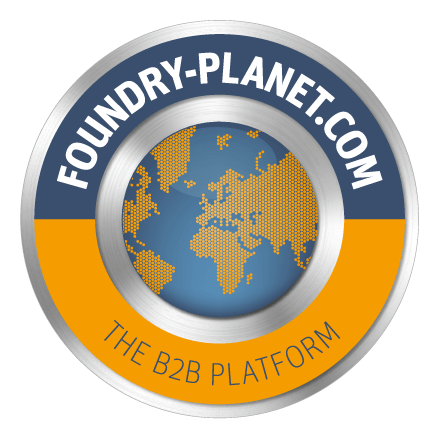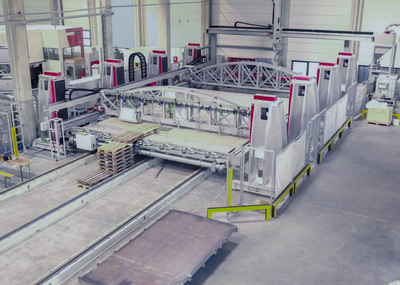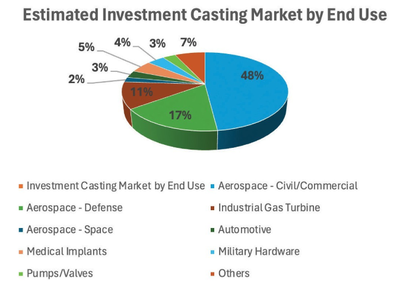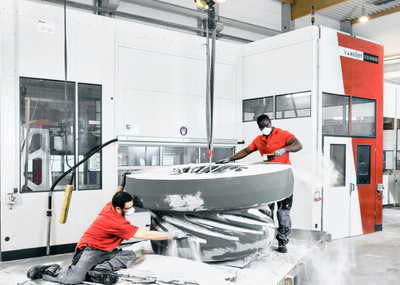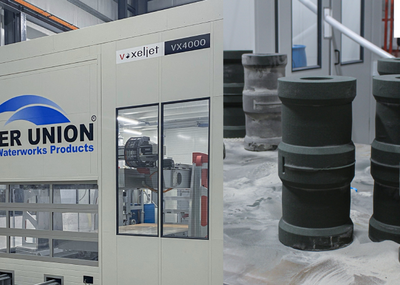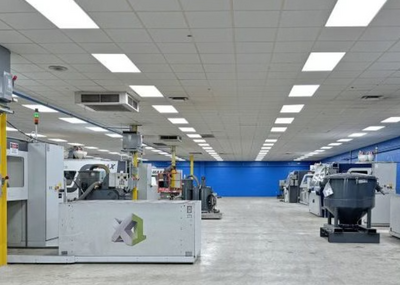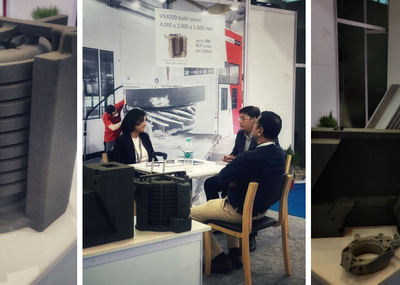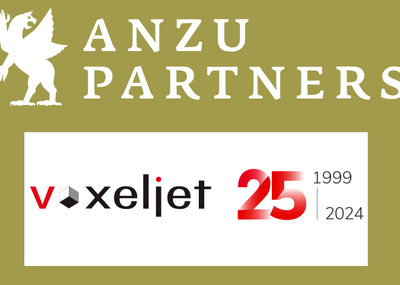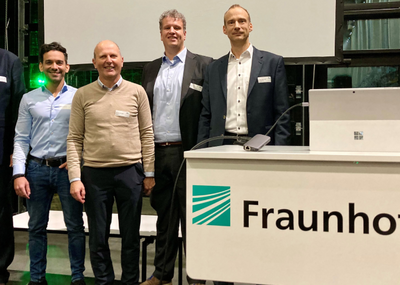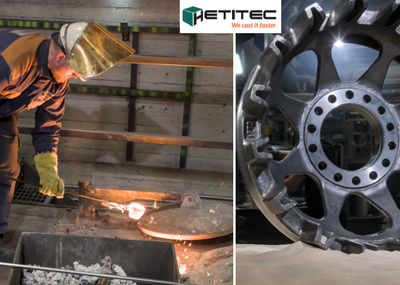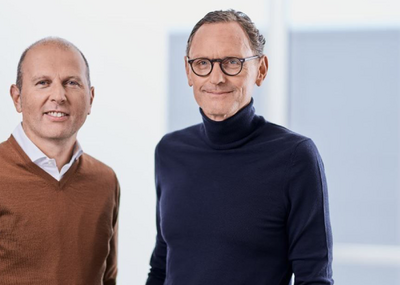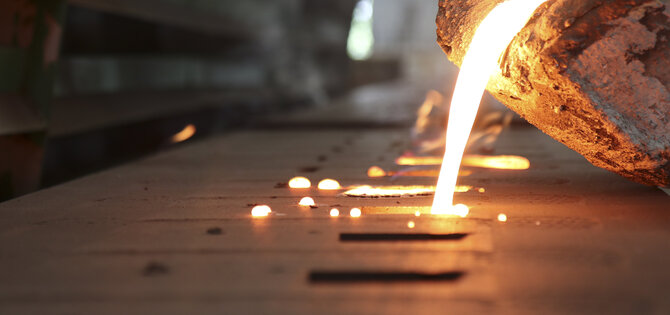Wax or PMMA?
TITAL relies on both lost wax casting and 3D printing of PMMA for the production of investment castings. In the lost wax process, the required wax patterns are traditionally produced by injecting wax into aluminum molds. The wax pattern is then fitted with a sprue system. The feeder and riser are glued on accordingly and the entire pattern is covered with a ceramic shell. After the ceramic shell is in place, the wax is melted out. What remains is a hollow ceramic mold into which the molten metal is poured. The process is similar when using PMMA 3D printed patterns, but with a key difference: instead of aluminum tools for the wax patterns, only 3D data is required. Another advantage is that the sprue system can be printed directly. "In addition, making the wax tools takes a certain amount of time, they are not very changeable and flexible but very cost-intensive," explains Rainer Sabisch. PMMA is a transparent thermoplastic material obtained by polymerizing the monomer methyl methacrylate. Due to its transparency and scratch resistance, PMMA is often used as a lightweight and shatterproof alternative to glass and is referred to as acrylic or Plexiglas. In 3D printing, it is processed as a powder and bonded layer by layer (layer thickness 150 µm) with a special binder to form three-dimensional objects. Voxeljets VX1000 is used for this. A large-format 3D printer with a build volume of 1,000 x 600 x 500 millimeters.
The question is: "When do I choose which process?" Florian Rauscher, Manager On-Demand Printing at voxeljet AG, explains: "The decisive factor is the number of parts needed. In series production, when the quantities become large, wax injection molds are unrivaled and still the first choice. PMMA systems are at their limit here, depending on the complexity of the geometry. Especially for simpler geometries, the tooling costs are manageable and therefore the break-even is relatively low compared to 3D printing. Also, in terms of part cost." A wax pattern molded over a tool costs less than a PMMA model. However, the production of those necessary tools is very expensive initially. TITAL has the corresponding production equipment in-house. The investment casting specialist can operate them in multiple shifts. The production of wax patterns is much faster, provided the tooling is already in stock. Additionally, higher capacities are possible via the wax injection molds set up in a series compared to PMMA 3D printing. The size of parts is not a factor in either process. "It is not a limiting parameter. TITAL can cast dimensions of up to 1.1 x 1.1 meters via both wax and PMMA, though not in one piece," says Rainer Sabisch.
Finally, consistency of is another factor. "If it is known that a motorsport company changes their design every two days, the manufacturers won’t be able to keep up with the constant tool changes," Sabisch says. In the aerospace sector, this applies to research and development. If a part goes through many iterations, especially in the initial phase, the use of PMMA patterns is more efficient and goal-oriented. "At least until the basis for series production is reached," adds Florian Rauscher. Thus, PMMA models are excellently suited for development purposes and small to medium series production.
First contact with 3D printing
TITAL first encountered 3D printing over 20 years ago. It all started with a toolmaker who, even then, was very active in 3D printing at that time. Back then, they were working with polystyrene. "Polystyrene powder in combination with the laser-sintering process was the first process on the market that we could use to generate parts for our purposes," Sabisch continues.
In 2005, voxeljet came along with its new PMMA material set. Ever since, TITAL has been purchasing PMMA patterns from voxeljet, who produces them using the binder jetting process. "The quality is good, the surface is good, the parameters are good," says Sabisch with satisfaction. PMMA has become increasingly popular and has gradually replaced polystyrene completely. The focus was on dimensional accuracy, less on material properties. It turned out that the dimensional accuracy of polystyrene was nowhere near as good as that of PMMA patterns. Laser sintering is a hot process in which the polystyrene material is melted by a laser. The energy and heat introduced by this process often causes distortion in the patterns. Instead, PMMA models are manufactured at room temperature, which is why no warping occurs and high dimensional accuracy is achieved. Another plus point is the negative coefficient of expansion of PMMA. Instead of expanding, PMMA simply collapses when it encounters heat, like when the model is burned out of the ceramic shell. When the ceramic is enrobed and fired, it is less likely that the shell will break.
DMLS (Direct Metal Laser Sintering): An alternative to 3D printing investment casting patterns?
In the past, TITAL's corporate parent, then named Arconic, operated some 3D printing manufacturing facilities in both development and production using metal 3D printing. However, the company distanced itself from purely metallic 3D printing during a restructuring phase over the past decade and has focused on investment casting. "I think metal 3D printing is good and exciting as such. It experienced a certain amount of hype and was an 'enabler' for us, opening doors to new technologies," says Rainer Sabisch. "However, some things did not materialize as we had hoped. The breakthrough failed to materialize. It turned out that metal 3D printing couldn't map everything after all, and it had a much harder time with safety-related aspects, including certification."
One of the main reasons for investment casting is the part size. With metal 3D printing, large-format, topology-optimized structures can hardly be produced. At least not in one piece. Most metal 3D printers offer build volumes averaging 300 x 400 x 400 millimeters. "With PMMA 3D printing, segmentation and subsequent assembly into a single part is possible," explains Florian Rauscher. "This way, customers can produce parts of up to 1.5 meters in size."
In metal printing, there is also the problem of anisotropy. The mechanical properties are not the same in every axis. With investment casting, on the other hand, the mechanical properties are always identical, regardless of the axis. This is not the case with a printed part, so that these are not yet approved for safety-relevant applications, or must be thoroughly checked.
The investment casting process has always been well established and qualified at TITAL. "We can produce safety-relevant, structurally highly stressed parts based on PMMA-printed patterns in the best quality, especially for the sensitive aerospace sector. That does not work with metal-printed parts," says Sabisch.
All around satisfied
Rainer Sabisch is very pleased with the collaboration with voxeljet: "voxeljet delivers high-precision PMMA patterns, even for very complex parts. They enable easy processability in the investment casting process and great design freedom for complex geometries." The resource-saving process can be easily integrated into existing production chains. Through 3D printing-supported investment casting production, TITAL simplifies workflows and benefits from reduced downtimes, which in turn has a positive effect on the casting price.
About TITAL
TITAL GmbH manufactures and develops highly complex, ready-to-install aluminum and titanium investment castings for well-known companies in aerospace, defense, electronics, optics, racing, mechanical engineering and medical technology. More than 90 percent of TITAL's customers are in the aerospace industry, including world leading aircraft manufacturers such as Airbus and Boeing as well as engine manufacturers such as Safran Aircraft Engines. The medium-sized investment casting specialist, which has been part of Howmet Aerospace (then Alcoa) since April 2015, was founded back in 1974 and benefits from over 45 years of experience in investment casting, topology optimization, design-to-cost and rapid prototyping. The Bestwig site in the Sauerland region of North Rhine-Westphalia currently employs around 600 people. The globally active parent company has locations in 20 countries with 65 plant branches and approximately 21,400 employees. In 2022, Howmet Aerospace achieved global sales of around 5.7 billion US dollars.
Investment Casting
Investment casting can be used to produce high-precision and filigree castings. Among the various casting processes, investment casting stands out as complex and labor-intensive. Instead of molding a negative from a solid model, the desired part is modeled from wax or plastic (e.g. PMMA) as a positive. The model is then coated with several layers of ceramic to produce a mold. When the ceramic is fired, the model melts and a hollow ceramic mold remains. The molten metal is then poured into this mold. Depending on the part, the multiple encapsulation process can take several days to weeks. After the melt has solidified, the mold is destroyed and the cast component is reworked or refined for final use. Virtually all castable alloys can be used for the investment casting process.
About TITAL / Howmet
As part of the American company Howmet Aerospace with many years of leading brand recognition in the aerospace components manufacturing sector and approx. 21,400 employees worldwide, TITAL GmbH, headquartered in Bestwig/Westphalia, near Arnsberg in North Rhine-Westphalia, is a manufacturer of globally sophisticated aluminum and titanium investment castings for leading aerospace companies.
About voxeljet
voxeljet is a leading provider of high-speed, large-format 3D printers and on-demand parts services to industrial and commercial customers. The Company’s 3D printers employ a powder binding, additive manufacturing technology to produce parts using various material sets, which consist of particulate materials and proprietary chemical binding agents. The Company provides its 3D printers and on-demand parts services to industrial and commercial customers serving the automotive, aerospace, film and entertainment, art and architecture, engineering, and consumer product end markets.
For more information, visit our website www.voxeljet.com
